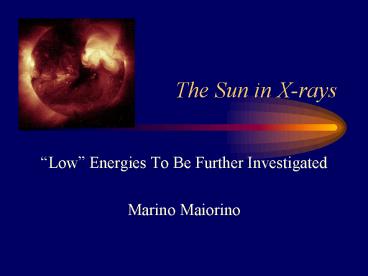The Sun in X-rays PowerPoint PPT Presentation
1 / 21
Title: The Sun in X-rays
1
The Sun in X-rays
- Low Energies To Be Further Investigated
- Marino Maiorino
2
Summary
- The Sun and Its Structure
- Light as a Measurement Tool
- The Corona Mistery
- The Present Theories
- Watch the Sun!
- Going to Space
- X-ray Imaging Detectors
- New Technologies
- Conclusions
3
The Sun and Its Structure
- Core
- p-p reaction
- 1.5107 K
- Radiative Zone
- Convective Mantle
- Outer, atmosphere layers
- Photosphere (5800 K)
- Chromosphere
- Transition region
- Corona
4
Light as a Measurement Tool
- Black body spectrum and a bunch of laws
- Temperature as a Function of Depth
- lmaxT constant!
5
The Corona Mystery
- Whats Corona?
- Outer atmosphere of the Sun.
- Thickness is a million km, but is possibly even
larger. - The Corona is too hot to emit visible light.
- How can we see it?
- During a solar eclipse, observe light reflected
from the dust particles associated with it. - Directly, using an X-ray telescope.
6
(No Transcript)
7
The Corona Mystery
- Temperatures in Corona
- Temperature gt 106 K emission in X-rays!
8
The Corona Mystery
- In literature you can find
- The reason for the enormous temperatures in the
corona is not well understood, but may relate to
heating by the Sun's magnetic field lines - Theories
- Wave dissipation
- Nano-flares
- Also see
- http//arxiv.org/PS_cache/astro-ph/pdf/0203/020316
7.pdf
9
The Present Theories
- Wave Dissipation
- Acoustic heating ruled out due to dependency of
Lx on rotational speed - Magneto-acoustic heating heating by waves and/or
particles induced from magnetic fields at the
bottom of the corona.
10
The Present Theories
- Nano-Flares
- Sun emits strong bursts of X-rays before the UV
lightning of flares - A large number of very small nano-flares was
proposed as a mechanism to heat Corona - Theory at 250000 K some magnetic reconnection
takes place between chromosphere and corona - SOHO saw low temp. gas (lt400000K) going down
hotter gas going up - Nowadays it is thought to be one of the
mechanisms involved in coronal heating, NOT the
most important one
11
Watch the Sun!
- Usefulness of a Sun-staring mission to monitor
Space weather - Short radio waves propagation (e.g. cellphones,
radars and antennas) - Artificial satellite communications (research,
GPS-navigation satellites) - Artificial satellite orbits (Earth atmosphere
inflation) - Electric power grids (tranformers overload)
- Health-damaging radiations (astronauts, jet
passengers)
12
Going to Space
- Our atmosphere, again...
13
X-ray Imaging Detectors
- History of X-ray detection in space
- Uhuru (US), 1970-73, 2-20 keV, proportional
counters - OSO7 (US), 1971-74, 1 keV 10 MeV, prop.
counters X-ray telescope - SAS3 (US), 1975-79, 0.1-60 keV, prop. counters
collimated - HEAO1 (US), 1977-79, 0.2 keV 10MeV, plenty of
experiments - Einstein (US), 1978-81, 0.2-20 keV, grazing
incidence telescope - Ginga (JAP), 1987-91, 1-500 keV, prop. counters
- GRANAT (RUS-EU), 1989-98, 2 keV 100 MeV, coded
mask telescope - ROSAT (D-US-UK), 1990-99, 0.1-2.5 keV, X-ray
telescope high resolution imager - XMM-Newton (EU), 1999, 0.1-15 keV, grazing
incidence X-ray imaging telescope - Chandra (US), 1999, 0.1-10 keV, grazing incidence
telescope
14
X-ray Imaging Detectors
- So low energies?
- 2106 K / 11604 172 eV (a few nm)
- In the soft X-ray band (0.12 - 5 keV) the Sun
is the brightest X-ray source (by a factor of
106) - X-ray Sun Luminosity 1027 erg/s!
15
X-ray Imaging Detectors
- Focusing Technologies
- X-ray (grazing) telescopes
- Coded mask aperture telescopes
- Detection Technologies
- Imaging Proportional Counters
- Microchannel Plates
- CCD Spectrometers
- Imaging Gas Scintillation Proportional Counters
16
X-ray Imaging Detectors
- Existing Projects
- SOHO (NASA-ESA)
- Yohkoh (JAP)
- GOES-12 (NASA-NOAA)
- TRACE (NASA) 171-1600 Å
- RHESSI (NASA) 3 keV 20 MeV
17
(No Transcript)
18
New Technologies
- Single-photon counters (Medipix)
- An X-ray photon generates two particle showers
(h and e-) in a solid-state detector - By suitably biasing the detector, one shower is
sent to an electronic device, able to see it as a
pulse - The electronic device is divided in picture
elements any of these pixels is able to count
the incoming pulses - Lower energy limit a few keV
19
New Technologies
- 3D detectors
- Electrodes are close
- Low full depletion bias
- Low collection distance
- Thickness NOT related to collection distance
- No charge spreading
- Fast charge collection
- Micron scale
- USE Latest MEM techniques
- Pixel device
- Readout each p column
20
New Technologies
- Josephson Junction Arrays
- Two superconductors, separated by an insulating
layer, form a Josephson Junction. - Cooper pairs can flow from one side to the other
- If a small voltage (a few millivolts) is applied,
an alternating current of frequency in the
microwave range results - Tecnology already used in SQUID detectors
(sensitive to magnetic fields) - By coupling the junction material to a particle
absorber, you can see particles (infrared
photons!) hitting the detector by monitoring the
voltage in the circuit
21
Conclusions
- Sun, our nearest star, still hides secrets...
even there where its more transparent... - Study of Sun is straightforward (well... lets
get to space, first...) - Imaging technologies are ready for new
challenges - A Sun-staring mission offers unusual economical
points of interest!

